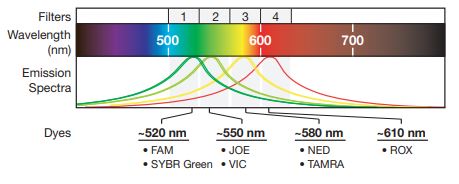THE PRIMARY COLOURS ARE RED, BLUE AND YELLOW
If you are an Artist and think about paint, this is probably what you think, but more about paint later in this section.
The primary colours of LIGHT are RED, BLUE and GREEN

We see things because light comes to our eyes where its energy is turned into electrical signals for our brain. The colour detectors in the eye are called CONES and there are three different types of cones. They each respond to different frequencies (colours). One type for red colour, one for green and one for blue.
So any colour which the brain “sees” is made up of combinations of red, blue and green. Have a look at the front of a colour telly screen with a magnifying glass, you will see that it is made up of lots of red, blue and green dots. The correct combination of these three colours gives any colour message to the brain.
If we shone Red, blue and green lights together at a white screen (OR had the red, green and blue dots on the telly ON) it would appear white because all 3 sets of cones are “working”. If any two of these three colours is shone at the screen then only 2 sets of the cones work and our brain gets a different message:
red and blue light only gives a purply colour called magenta
blue and green light only gives a peacock blue colour called cyan
red and gree light only gives the most surprising result yellow.
PAINTS: Paints have colours not because they EMIT light, but because they take away some of the colours from white light. (White light being made up of all the colours of the rainbow). Consequently any combination of paint takes even more colours away from the white light, so a combination of paints works differently to a combination of coloured lights.
Ever noticed how difficult it is to tell colours of cars under orange street lights? That is because it is orange and not white light which is falling on the paint of the cars.

Taking this a bit further we could consider inks from your printer for a color print:
magenta ink reflects red and blue light to the eye (absorbing green)
yellow ink reflects red and green light to the eye (absorbing blue)
Cyan ink reflects blue and green light to the eye (absorbing red)
if these inks are overlaid then see what is absorbed (from the above list) and therefore work out what color is left example given: if magenta and yellow ink are overlaid then green AND blue are absorbed…leaving only red.

